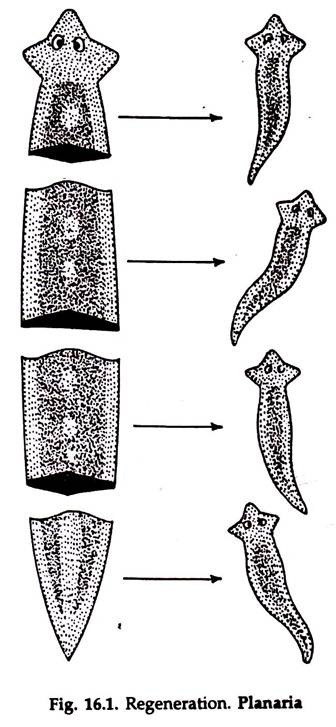The following points highlight the four special modes of reproduction in animals. The special modes are: 1. Parthenogenesis 2. Paedogenesis (Neoteny) 3. Polyembryony 4. Regeneration.
Special Mode # 1. Parthenogenesis:
Development of an unfertilized egg into an adult is parthenogenesis (Gr. perthenos = virgin + gene = birth). A number of abiotic factors, viz. pH, salinity of the water (in aquatic forms), temperature, chemicals and mechanical stimuli induce parthenogenetic development of eggs in many species.
It is common in many insects, viz. ants, termites, aphids, bees, wasps, etc. In most of the parthenogenetic species, pre-gametic meiosis is absent and the eggs contain diploid number of chromosomes. Some species of rotifers produce both haploid and diploid eggs. In rotifers and some lizards males are unknown.
Parthenogenesis occurs in aphids (insects) and water fleas (crustacea) for several generations, following which males are produced and mating occurs. Parthenogenesis may be sex related. In honey bee, queens and workers develop from fertilized eggs and drones (males) from unfertilized eggs.
Special Mode # 2. Paedogenesis (Neoteny):
ADVERTISEMENTS:
Sexual reproduction in the larval or pre-adult stage is paedogenesis. This has evolved presumably in response to the advent of unfavorable conditions threatening survival before attaining adulthood and reproducing sexually.
The axolotl larva of salamander Ambystoma tigrinum, still possessing gills, develop sex organs and breeds regularly. Some of the diptera, gall midges, reproduce sexually in their larval and pupal stages.
Special Mode # 3. Polyembryony:
Appearance of a few individuals, instead of one, from a single fertilized ovum is polyembryony. It is formed both in invertebrates and vertebrates. The parasitic hymenoptera, Ageniaspis fuscicollis produces 10 to 15 and Litomastix truncatellus about 2,000 larvae from one fertilized egg.
Polyembryony is common in bryozoa. The nine-banded armadillo, Tatusia novemeineta produces 4 to 5 and other species up to eight or nine embryos from one fertilized egg.
Special Mode # 4. Regeneration:
ADVERTISEMENTS:
The ability to reconstruct a lost part of the body is regeneration. Strictly, it is not considered as reproduction. Regeneration occurs in many animals belonging to widely diverse groups. A cell can grow the lost part provided the nucleus is not damaged.
Damaged neurons not involving the cell body can reconstruct the lost portion. A hydra can reconstruct any of its lost part within a short period. Sea anemone can regenerate new individuals from fragments of tissues from the basal disc.
The regeneration capability of planaria (Fig. 16.1) is remarkable. Any part of the body separated can build up the missing portion and forms a new individual. Gastropod molluscs can regenerate their both tentacles with eyes, even if they are lost at a time. A starfish can reconstruct the whole body from a broken arm.
Many crustacea can grow lost legs. Salamanders, lizards can built new legs and tails if the original one is lost. The victim escapes by detaching the body parts seized by an enemy or a predator, and this is considered as an adaptation for defence.
ADVERTISEMENTS:
Union of broken bones and healing of wounds are viewed as regeneration. Though in a much less degree, regeneration occurs in birds and mammals. Large areas of damaged epidermal tissue, damaged blood vessels and liver tissues redevelop.
